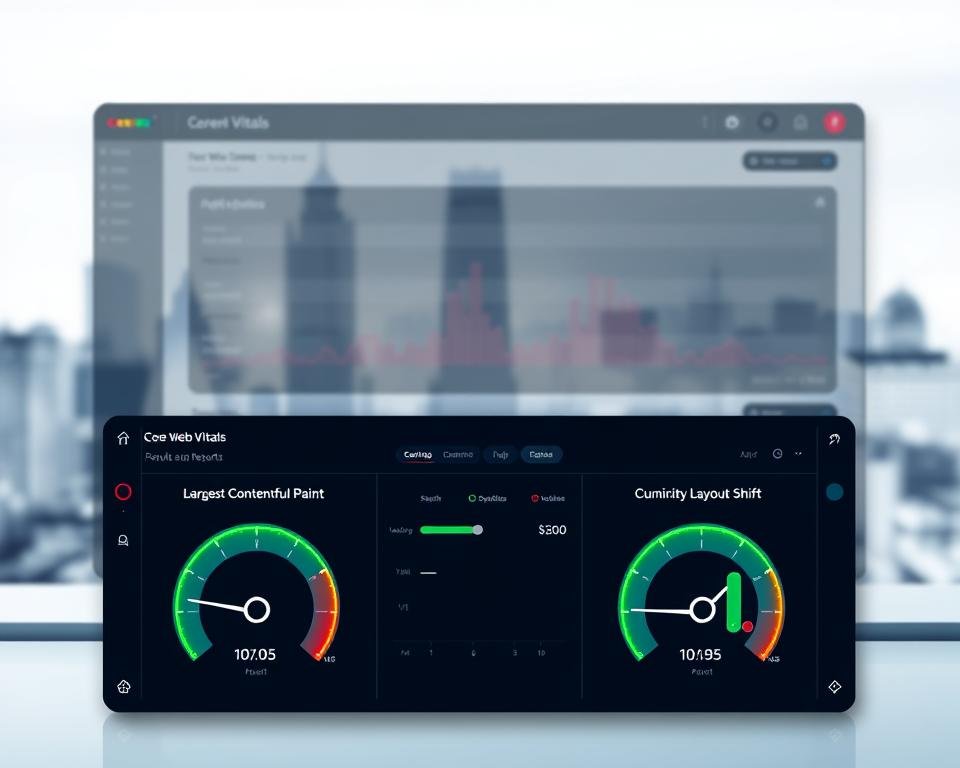As a website owner, understanding Core Web Vitals is crucial for improving your search engine rankings. Google considers these specific factors when ranking websites, focusing on the user experience.
I’ll break down this new Google metric and explain why it’s essential for your website’s performance. Core Web Vitals are a set of metrics that measure the user experience, including loading speed, interactivity, and visual stability.
By optimizing these factors, you can improve your website’s ranking and provide a better experience for your users.
Key Takeaways
- Core Web Vitals are a set of specific factors that Google considers when ranking websites.
- These factors focus on the user experience, including loading speed, interactivity, and visual stability.
- Optimizing Core Web Vitals can improve your website’s search engine rankings.
- A better user experience is a byproduct of optimizing Core Web Vitals.
- Understanding Core Web Vitals is crucial for website owners who want to improve their search engine rankings.
Introduction to Core Web Vitals
As we dive into the world of website optimization, it’s crucial to understand the role of Core Web Vitals in enhancing user experience. Core Web Vitals are a set of metrics that measure the performance and usability of a website, focusing on aspects that directly impact how users interact with a site.
Core Web Vitals are designed to provide a unified guide to the quality of user experience on the web. They are crucial because they help website owners and developers identify areas that need improvement to provide a better experience for their users.
Definition of Core Web Vitals
Core Web Vitals are a subset of web vitals that measure the loading, interactivity, and visual stability of web pages. They are designed to capture the essence of a user’s experience on a website, providing insights into how quickly a page loads, how soon it becomes interactive, and how stable the layout is during the loading process.
Importance for Website Performance
The importance of Core Web Vitals lies in their direct impact on user experience and, subsequently, on a website’s search engine ranking. Google has emphasized the significance of these metrics by incorporating them into its ranking algorithm. A website that performs well on Core Web Vitals is likely to provide a better user experience, which can lead to higher engagement rates and improved conversion rates.
By focusing on Core Web Vitals, website owners can gain valuable insights into their site’s performance and make data-driven decisions to improve user satisfaction. This, in turn, can positively impact their website’s visibility and ranking on search engines.
The Three Main Metrics of Core Web Vitals
Understanding the core metrics of Core Web Vitals is crucial for enhancing website performance. These metrics provide insights into how users experience a website, helping developers identify areas for improvement.
Largest Contentful Paint (LCP)
Largest Contentful Paint (LCP) measures the time it takes for the largest content element to become visible within the viewport. This metric is crucial because it indicates when the main content of a webpage has loaded, allowing users to engage with it.
Key factors influencing LCP include:
- Server response times
- Resource load times
- Client-side rendering
To improve LCP, consider optimizing images, leveraging browser caching, and minimizing CSS and JavaScript files.

First Input Delay (FID)
First Input Delay (FID) measures the time it takes for a website to become interactive. It quantifies the delay between a user’s first interaction with a page (like clicking a button) and the browser’s response to that interaction.
Factors affecting FID include:
- JavaScript execution times
- Main thread work
- Poorly optimized code
Enhancing FID involves minimizing JavaScript execution times, breaking up long tasks, and optimizing code.
Cumulative Layout Shift (CLS)
Cumulative Layout Shift (CLS) measures the stability of the layout as it loads. It quantifies how much the content shifts around during the loading process, impacting user experience.
Common causes of CLS include:
- Dynamically injected content
- Images without dimensions
- Advertisements that shift content
To reduce CLS, ensure that images and videos have specified dimensions, and avoid inserting new content above existing content.
Impact of Core Web Vitals on User Experience
As I explore the world of web development, I find that Core Web Vitals play a significant role in shaping user experience. A website’s performance is no longer just about aesthetics; it’s about creating an environment where users can engage seamlessly with the content.
The importance of Core Web Vitals cannot be overstated. With the majority of users accessing websites through mobile devices, a fast and responsive website is crucial for capturing and retaining user attention. Page load speed is a critical factor in this regard, as it directly influences user satisfaction and engagement.
Importance of Page Load Speed
Page load speed is a vital component of Core Web Vitals, and its impact on user experience is multifaceted. A slow-loading website can lead to high bounce rates, as users are unlikely to wait for a page to load. Conversely, a fast-loading website can improve user engagement, leading to higher conversion rates.
| Page Load Speed | User Engagement | Conversion Rate |
|---|---|---|
| Less than 3 seconds | High | Higher conversion rates |
| 3-5 seconds | Moderate | Average conversion rates |
| More than 5 seconds | Low | Lower conversion rates |
Enhancing User Engagement
Enhancing user engagement is a direct result of optimizing Core Web Vitals. By ensuring that a website loads quickly and responds promptly to user interactions, developers can create a more engaging user experience. This, in turn, can lead to higher user retention rates and improved SEO performance.

To further enhance user engagement, it’s essential to consider the interplay between Core Web Vitals and other aspects of web development, such as content quality and user interface design. By adopting a holistic approach to web development, developers can create websites that not only meet but exceed user expectations.
How Google Evaluates Core Web Vitals
As part of its page experience update, Google incorporates Core Web Vitals into its ranking signals, making it crucial for website owners to understand this evaluation process.
Signals in Search Ranking
Google uses Core Web Vitals as a signal in its search ranking algorithm to ensure that users are directed to websites that provide a good page experience. This means that websites with better Core Web Vitals scores are likely to rank higher in search results.
The importance of Core Web Vitals in search ranking cannot be overstated. A good score indicates that a website is user-friendly, loads quickly, and is stable, all of which are factors that Google considers when ranking sites.
| Core Web Vitals Metric | Description | Impact on Ranking |
|---|---|---|
| Largest Contentful Paint (LCP) | Measures loading performance | Faster LCP scores improve ranking |
| First Input Delay (FID) | Measures interactivity | Lower FID scores enhance user experience and ranking |
| Cumulative Layout Shift (CLS) | Measures visual stability | Lower CLS scores indicate better stability and higher ranking potential |
Debugging Tools Provided by Google
To help website owners measure and improve their Core Web Vitals, Google provides several debugging tools.
One of the primary tools is PageSpeed Insights, which analyzes a website’s performance on both desktop and mobile devices, providing scores and recommendations for improvement.
Another valuable tool is Lighthouse, an open-source, automated tool for improving the quality of web pages. It provides audits for performance, accessibility, SEO, and more, helping developers identify and fix issues that may be impacting their Core Web Vitals.
By utilizing these tools, website owners can gain insights into their website’s performance and make data-driven decisions to enhance their Core Web Vitals, ultimately improving their search rankings.
Benefits of Optimizing Core Web Vitals
The benefits of optimizing Core Web Vitals are multifaceted, impacting both SEO and user engagement. By enhancing your website’s loading speed, interactivity, and visual stability, you can improve your search engine rankings and provide a better user experience.
Improved SEO Performance
Optimizing Core Web Vitals directly influences your website’s SEO performance. Search engines like Google prioritize websites that offer a smooth and efficient user experience. By improving metrics such as Largest Contentful Paint (LCP), First Input Delay (FID), and Cumulative Layout Shift (CLS), you can enhance your website’s visibility in search results.
For instance, a faster LCP can lead to higher engagement rates, as users are more likely to stay on a page that loads quickly. Here’s a comparison of how different LCP times can affect user behavior:
| LCP Time | User Behavior | Impact on SEO |
|---|---|---|
| 0-2 seconds | High engagement, low bounce rates | Positive impact, potentially higher rankings |
| 2-4 seconds | Moderate engagement, moderate bounce rates | Neutral impact, may not significantly affect rankings |
| 4+ seconds | Low engagement, high bounce rates | Negative impact, potentially lower rankings |

Higher User Retention Rates
Enhancing Core Web Vitals not only improves SEO but also significantly boosts user retention rates. A website that is interactive and visually stable encourages users to stay longer and engage more deeply with the content.
For example, reducing Cumulative Layout Shift (CLS) can prevent users from accidentally clicking on the wrong elements, thereby improving their overall experience. Here are some strategies to achieve higher user retention:
- Optimize images and videos to reduce load times
- Minimize the use of heavy JavaScript files
- Ensure that your website is mobile-friendly
By implementing these strategies and focusing on Core Web Vitals, you can create a more user-friendly and SEO-optimized website, ultimately leading to better performance and higher user satisfaction.
Common Challenges in Achieving Good Core Web Vitals
Optimizing Core Web Vitals can be daunting for many website owners, who often encounter technical limitations and resource constraints. Achieving good Core Web Vitals requires a multifaceted approach that addresses various aspects of website performance.
Technical Limitations
One of the primary challenges is technical limitations. Slow server response times, resource-intensive scripts, and unoptimized images can significantly hinder a website’s performance. For instance, slow server response times can delay the Largest Contentful Paint (LCP), affecting the overall user experience.
A detailed analysis of common technical issues and their impact on Core Web Vitals is crucial. The table below summarizes some of these challenges and potential mitigation strategies.
| Technical Issue | Impact on Core Web Vitals | Mitigation Strategy |
|---|---|---|
| Slow Server Response Times | Delays LCP | Optimize server configuration, leverage content delivery networks (CDNs) |
| Resource-Intensive Scripts | Affects First Input Delay (FID) | Minify and compress JavaScript files, code splitting |
| Unoptimized Images | Impacts LCP and Cumulative Layout Shift (CLS) | Compress images, use responsive image techniques |
Resource Allocation
Adequate resource allocation is another critical factor. Allocating sufficient resources for optimization efforts, such as hiring experts or investing in optimization tools, can be challenging for many organizations. Effective resource allocation involves prioritizing tasks based on their impact on Core Web Vitals.

By understanding these challenges and implementing strategies to overcome them, website owners can improve their Core Web Vitals, enhancing both user experience and search engine rankings.
Tools to Measure Core Web Vitals
Google provides several tools to help you assess and improve your website’s Core Web Vitals. These tools are designed to give you insights into your website’s performance and offer recommendations for improvement.
Google PageSpeed Insights
Google PageSpeed Insights is a powerful tool that analyzes your website’s performance on both desktop and mobile devices. It provides a score based on your website’s loading speed, interactivity, and visual stability, along with suggestions for improvement.
To use Google PageSpeed Insights, simply enter your website’s URL, and the tool will generate a report detailing your website’s performance metrics, including Largest Contentful Paint (LCP), First Input Delay (FID), and Cumulative Layout Shift (CLS).

Lighthouse Reports
Lighthouse Reports are another valuable resource provided by Google. Lighthouse is an open-source, automated tool for improving the quality of web pages. It provides audits for performance, accessibility, SEO, and more.
Lighthouse Reports can be generated using Google Chrome’s DevTools, offering a comprehensive analysis of your website’s performance and providing actionable recommendations to enhance your website’s Core Web Vitals.
By utilizing these tools, you can gain a deeper understanding of your website’s performance and identify areas for improvement, ultimately enhancing your website’s user experience and search engine ranking.
Best Practices for Improving Core Web Vitals
Enhancing Core Web Vitals requires a combination of technical optimizations and strategic best practices. By implementing these strategies, you can significantly improve your website’s performance, leading to better search engine rankings and a more satisfying user experience.
Image Optimization Techniques
Optimizing images is crucial for improving Core Web Vitals, particularly Largest Contentful Paint (LCP). Here are some techniques to optimize images:
- Compress images: Use tools like TinyPNG or ImageOptim to compress images without compromising quality.
- Use responsive images: Ensure that images are responsive and can adapt to different screen sizes and devices.
- Lazy loading: Implement lazy loading to defer the loading of images until they come into view.
- Use WebP format: Use the WebP image format, which provides better compression than JPEG and PNG.

Reducing JavaScript Load
Reducing JavaScript load is essential for improving First Input Delay (FID) and overall website performance. Here are some strategies to reduce JavaScript load:
- Minify and compress JavaScript files: Use tools like Gzip or Brotli to compress JavaScript files.
- Code splitting: Split JavaScript code into smaller chunks and load them on demand.
- Avoid unnecessary JavaScript: Remove unnecessary JavaScript code and libraries to reduce the overall load.
- Use async and defer attributes: Use the async and defer attributes to control the loading of JavaScript files.
By implementing these best practices, you can significantly improve your website’s Core Web Vitals, leading to better search engine rankings and a more satisfying user experience.
Case Studies: Success Stories of Optimization
Real-world examples show that optimizing Core Web Vitals leads to improved search engine rankings and a better user experience. In this section, we will explore some notable case studies that demonstrate the effectiveness of Core Web Vitals optimization.
Real-World Examples
Several prominent websites have achieved significant improvements in their performance by focusing on Core Web Vitals. For instance, a leading e-commerce platform was able to increase its conversion rates by 15% after optimizing its Largest Contentful Paint (LCP) and Cumulative Layout Shift (CLS).
Key optimizations included: Image compression, lazy loading, and minimizing JavaScript execution time.
Another example is a news website that reduced its First Input Delay (FID) by 200 milliseconds, resulting in a 10% increase in user engagement.
Metrics Before and After Implementation
The following table illustrates the improvements achieved by these websites before and after optimizing their Core Web Vitals:
| Website | Metric | Before Optimization | After Optimization |
|---|---|---|---|
| E-commerce Platform | LCP | 4.2 seconds | 2.5 seconds |
| E-commerce Platform | CLS | 0.25 | 0.1 |
| News Website | FID | 250 ms | 50 ms |

These case studies demonstrate the tangible benefits of optimizing Core Web Vitals, including improved search engine rankings, increased user engagement, and higher conversion rates.
Future of Core Web Vitals in SEO
Core Web Vitals will remain a key factor in SEO as Google refines its algorithm to enhance user experience. As we look to the future, it’s essential to understand how Core Web Vitals will evolve and impact SEO strategies.
Upcoming Google Algorithm Changes
Google continuously updates its algorithm to improve search results and user experience. Recent announcements indicate that Core Web Vitals will play an increasingly important role in these updates. Some key changes to watch include:
- Enhanced Page Experience Signals: Google may further integrate page experience signals into its ranking algorithm, making Core Web Vitals even more critical for SEO.
- Mobile-First Indexing: As mobile-first indexing becomes the norm, optimizing for Core Web Vitals on mobile devices will be crucial.
- New Metrics and Thresholds: Google may introduce new metrics or adjust existing thresholds for Core Web Vitals, requiring ongoing optimization efforts.
Long-Term Effects on Web Development
The emphasis on Core Web Vitals is driving significant changes in web development practices. In the long term, we can expect to see:
- Improved Performance: Websites will need to be optimized for faster load times, better responsiveness, and reduced layout shifts.
- Evolution of Web Technologies: The development of new web technologies and frameworks will be influenced by the need to meet Core Web Vitals standards.
- Shift in Resource Allocation: Web development teams may need to allocate more resources to optimizing Core Web Vitals, potentially impacting project timelines and budgets.
By understanding these changes and adapting to the evolving landscape of Core Web Vitals, developers and SEO professionals can ensure their websites remain competitive and user-friendly.
Conclusion: Prioritize Core Web Vitals for Better Rankings
As we’ve explored throughout this article, Core Web Vitals play a crucial role in determining search engine rankings and user experience. By understanding and optimizing these metrics, website owners can significantly improve their online presence.
Actionable Insights for Website Owners
Prioritizing Core Web Vitals involves several key takeaways. First, it’s essential to focus on the three main metrics: Largest Contentful Paint, First Input Delay, and Cumulative Layout Shift. By optimizing these areas, website owners can enhance page load speed, improve user engagement, and ultimately drive better search engine rankings.
Take the First Step Towards Optimization
Starting optimization now is crucial for long-term success. I recommend using tools like Google PageSpeed Insights and Lighthouse Reports to measure and improve your Core Web Vitals. By prioritizing these metrics and implementing best practices, you can improve your website’s performance and stay ahead of the competition.
